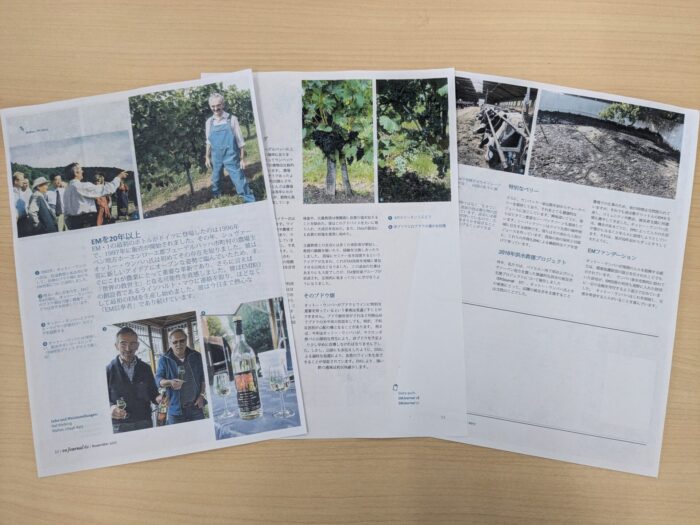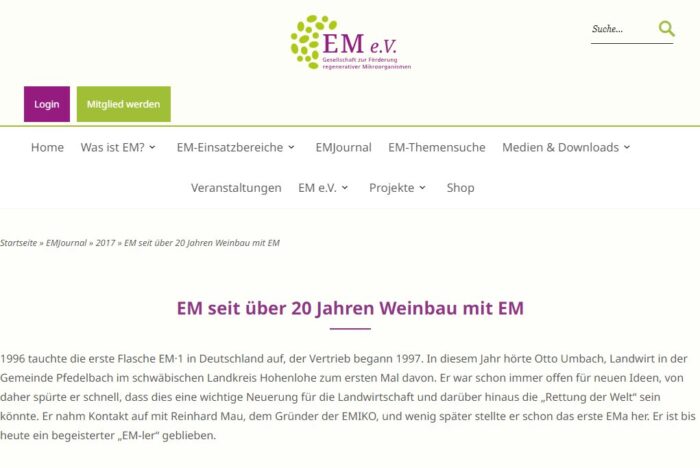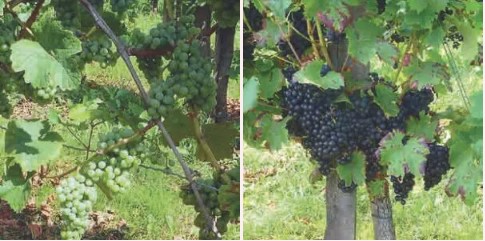
In the last article I wrote about the 2nd Ichiro Masaki Memorial Universal Village EM International Conference and at that time in addition to the presentations, I received a lot of other information.
A participant from Germany gave me an article from the EM Journal, November 2017 issue, (EM Journal) and a gift of a wonderful bottle of EM rosé wine.
This is a report on the steady success of Otto Umbach’s vineyard, which I visited after the EM Europe conference in Germany in 2002.
This article is not only about the grapes, but also about the diverse activities that Mr. Umbach is actively engaged in to contribute to society, which function as an essential social asset for local development.
In this article I advised the use of salt to prevent EM from deteriorating, and I would like all of us to reaffirm the importance of this combined use of salt. The use of EM has now spread throughout Europe and is beginning to form the core of the Universal Village. We can look forward to new social developments using EM in the near future.
You can read this article on the official EM e.V. website. The following is a translation of that article. (This article is reprinted and quoted with official permission from EM e.V., Germany.)

The first bottle of EM·1 appeared in Germany in 1996, and sales began in 1997. That was the year that Otto Umbach, a farmer in the community of Pfedelbach in the Swabian district of Hohenlohe, heard about it for the first time. He has always been open to new ideas, so he quickly sensed that this could be an important innovation for agriculture and, moreover, “save the world.” He contacted Reinhard Mau, the founder of EMIKO, and shortly afterwards he produced the first EMa. He has remained an enthusiastic “EM-er” to this day.

Right: Regent grapes in August, left: Abundant harvest of red and white grapes
The Stöcking farm is located above Pfedelbach, very close to the vineyards. The farm has been in the hands of the Umbach family for several generations, though most of the buildings are more recent, with only the old barn still standing from before. The farm has retained the diversity that used to characterize most farms. There are 50 dairy cattle plus their offspring, pastures, arable farming, and most of the feed is produced on site: silage has been reliably fermented with EM for many years, but grain is also marketed and, of course, wine.
Otto and his son Reiner have been equal partners since 2003; while the vineyard and wine, EM production and a number of other activities on the farm are Otto’s domain, Reiner is responsible for everything that happens in the fields, and he makes EM silage, takes care of the marketing of milk and grain, etc. However, many things are still discussed and done jointly across generations. From the very beginning, Otto’s wife, Elisabeth, has used EM very successfully in the house and in her large garden.
Fresh EM is always available on the Stöcking farm. Therefore, there is practically no work process in which EM is not used, and no watering barrel is driven out without EM. Over the years, it has become routine to use EM in all areas. This is certainly also due to the fact that OtMr. Umbachto initially attached devices to his agricultural equipment so that EM could be applied in all work processes without any additional effort.
One of Prof. Higa’s first visits to Germany was scheduled for July 2002. Since Mr. Kuwabara, the head of the EMRO base in Germany, lived in the neighboring Bretzfeld (where EMRO Europe is now headquartered), a visit to the Stöcking farm was arranged. At the time, there was a problem in one of his vineyards that Mr. Umbach was apparently unable to solve with EMa alone. During the visit, Prof. Higa recommended that he add good salt to the spray mixture. He then took this to heart and was successful. He also began using good rock salt in the production of EMa at that time.
Many visitors came to the meeting with Prof. Higa to listen to his lecture and exchange their experiences. Thus was born the idea of a seminar room on the farm, which would become the starting point for the dissemination of EM technology in the region. Even though this additional task turned out to be too much work, a group of EM enthusiasts was formed who met regularly to learn from each other.
It is obvious that Mr. Umbach is particularly fond of grapes and wine. However, as much as the winemaker cares about the well-being of his plants and berries, there are still times when adverse circumstances cause concern. This year, for example, he had to harvest his red grapes – and now also his white ones – a little earlier than he had hoped due to the heavy infestation by the spotted wing drosophila. But as we have already reported, treating the grapes with EM in good time means that they can still be made into good wine. The strong vinegar taste is reduced by around 50% thanks to EM.
In addition, the Umbachs have been growing Aronia, the chokeberry, for several years, which they process into a very healthy juice. Interestingly, they also grow the vitamin-rich sea buckthorn, which is well-known in the northern German coastal regions, and make a popular juice from its berries. Like everywhere else on the farm, these crops are also grown with continuous EM care.
Last year we reported on aid projects following the devastating floods in Lower Bavaria and Swabia (EMJournal 57). It was a matter of course for Mr. Umbach and his family to help those affected in the neighboring community. Working on the farm naturally limits his time, but he has produced several thousand liters of EM and has spent weeks helping out, whether in the communities, church congregations, or the people affected themselves. As he has done for twenty years, Mr. Umbach always tries to convince people, whenever the opportunity arises, that EM will enrich their lives.
Seealso:
EMJournal 28
EMJournal 57
Categories: 2017, EM, EMJournal , EMJournal 62, Experience report
Tags: EM wine
Read the original Japanese message at the link below.
2025.2.1 Updated.